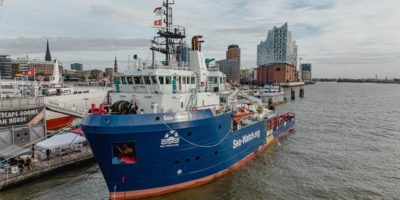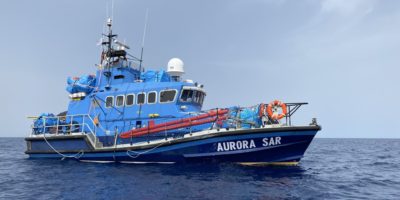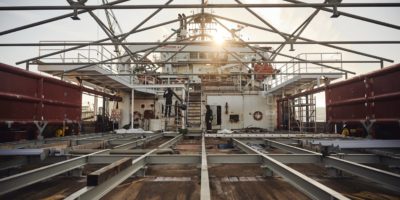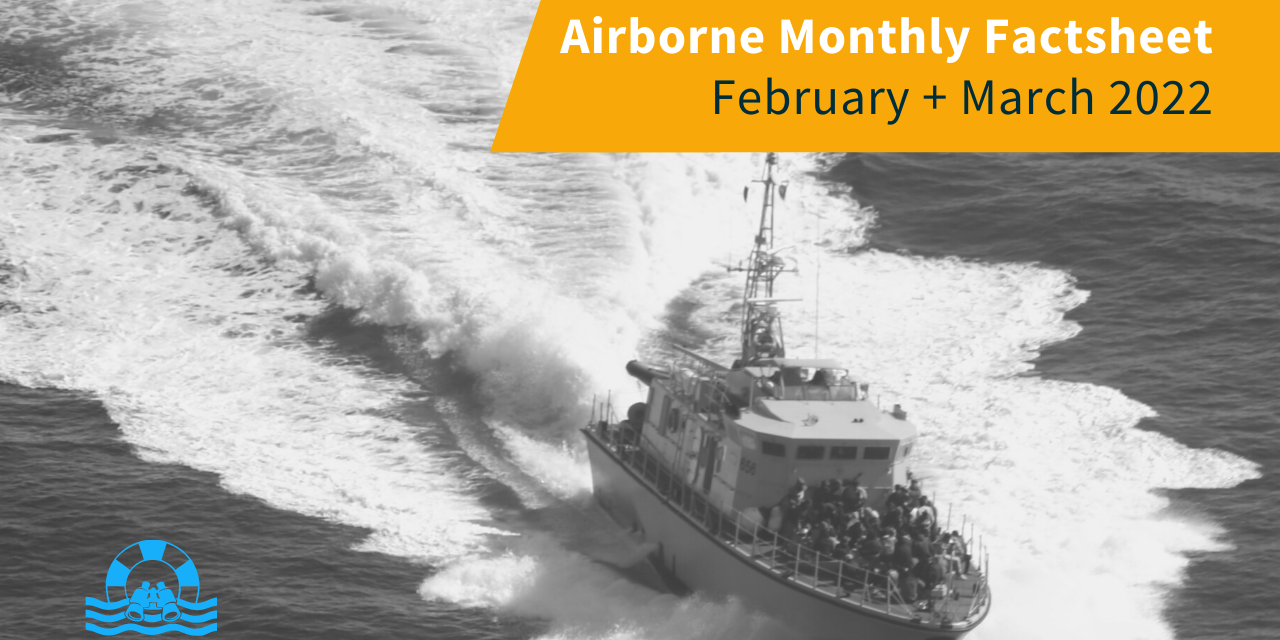This factsheet outlines a summary of the distress cases witnessed in February and March 2022 by Sea-Watch’s Airborne Operations with the aircraft Seabird and Seabird 2.* In February and March 2022 we conducted 12 operations, with a total flight time of 72 hours and 48 minutes. We spotted 2 boats, carrying around 158 persons in distress.
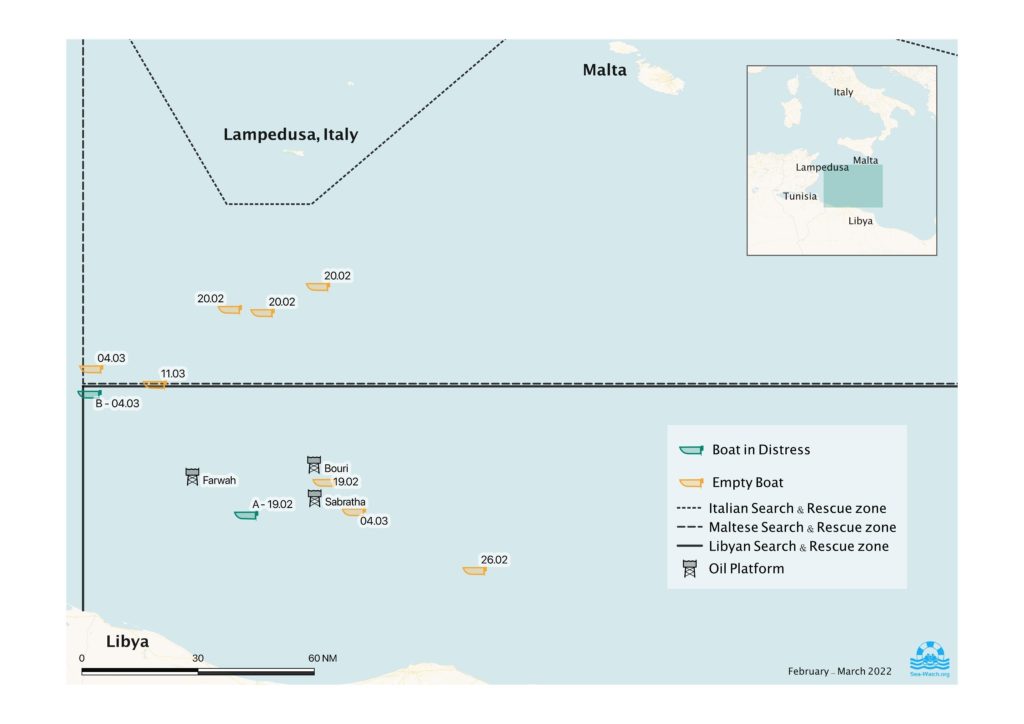
Overview of boats in distress and empty boats spotted
Libyan Search-and-Rescue (SAR) zone
- 1 distress case, with 8 persons, was rescued by the NGO vessel Sea-Watch 4 and disembarked in Porto Empedocle, Italy
- 1 distress case, with around 150 persons, was intercepted by the so-called Libyan Coast Guard and pulled back to Libya
- Estimated number of persons in distress**: around 158
Details and outcomes of selected boats in distress and empty boats
19.02., distress case A, 8 persons: Joint rescue operation by civil society, NGOs again filling the gaps left by European authorities in the central Mediterranean. On 19.02., the crew of Seabird 2 spotted 8 persons in distress in the Libyan SAR zone. The crew immediately informed the NGO vessel Sea-Watch 4 on the radio, which was only around 5 nautical miles (nm)*** away from the people in distress and the closest vessel to the case. Half an hour later, Sea-Watch 4’s RHIBs**** were on-scene and able to take the people safely on board. 129 persons from two different rescue operations were disembarked on 26.02. in Porto Empedocle, Italy.
04.03., distress case B, around 150 persons: Interception by the so-called Libyan Coast Guard likely coordinated by Frontex. During the morning Frontex’s drone, operated in cooperation with the Armed Forces of Malta, was observed orbiting in the Libyan SAR zone. Around two hours later, Seabird’s crew saw the people in distress as well as the so-called Libyan Coast Guard patrol boat 656, which was approaching with around 40 persons already on its deck. The people were intercepted by the so-called Libyan Coast Guard and pulled back to Libya. Later, the NGO vessel Open Arms also spotted the Libyan patrol boat with the intercepted persons. Again, we must assume that Frontex coordinated a pullback to Libya, in violation of international maritime and human rights law.
Since 05.03, Seabird and Seabird 2 have been denied permission to fly over the Libyan SAR zone.
In February and March, Seabird and Seabird 2’s crews spotted 8 empty boats. One empty boat was spotted on two occasions, on 11. and 12.03. One was likely intercepted. The other 7 boats could not be matched with known cases.
In February and March, we must assume that the European Coast Guard Agency Frontex was involved in the narratives for at least 1 boat and 1 empty boat sighted by Seabird, where on open sources the drone could be observed orbiting the relevant positions before Seabird’s crew arrived on-scene. The boat was intercepted and pulled back to Libya. The outcome for the empty boat is unknown.
Unlawful restrictions in the air
On 05.03., the Libyan authorities informed Seabird 2’s crew on the radio that they were not permitted to enter the Libyan Flight Information Region (FIR)***** in order to fly above the Libyan SAR zone. Afterwards, the crew unsuccessfully tried to reach the Libyan aviation authorities via phone, to clarify the matter.
Again on 11.03., the Libyan authorities refused Seabird’s crew entry to the Libyan FIR, requesting a permit number that we did not have, since such a number is ordinarily not required.
According to the Chicago Convention, Libya has jurisdiction over its territory up to 12 nautical miles offshore but not more. Therefore, the restrictions of the Libyan authorities contradict the Chicago Convention and rules relating to aviation law.
In 2021, 96 of the 190 boats in distress spotted were in the Libyan SAR zone. Restricting the right to fly of civilian aircraft over the Libyan SAR zone acutely hinders our operations and endangers the existence of the entire project. The consequence is severe: boats in distress in the Libyan SAR zone can no longer be spotted from the air. Relevant information is no longer passed on to potential rescue capacities. Rescues of people in distress at sea with subsequent disembarkation in a safe port in Europe thus become less likely.
These attempts coincide with threats from the so-called Libyan Coast Guard to NGO vessels, illegally requesting the NGO vessels to leave the Libyan SAR zone, even though the vessels are allowed to sail freely in international waters******
Sea-Watch and Humanitarian Pilots Initiative document human rights violations in the central Mediterranean. In 2021, the NGOs conducted 121 operations, for 714 hours and 45 minutes, spotting more than 11.137 persons in distress aboard 190 boats. We were able to document numerous severe human rights violations through our monitoring flights, such as non-assistance cases or situations of deadly cooperation between European authorities and the so-called Libyan Coast Guard and pullbacks to Libya.
Unfortunately, this is not the first such measure aimed at hindering our operations which has been taken.******* Such attempts drastically threaten our operations. The aim is clear: hindering the documentation of human rights violations and closing the civilian eye over the sea, so that no one is to know what is actually happening in the central Mediterranean.
* Since 2017, together with the Swiss NGO Humanitarian Pilots Initiative, Sea-Watch monitors the Central Mediterranean with its aircraft Moonbird and Seabird.
** These numbers are based upon the estimations of Seabird 2’s crews and the number provided by the Sea-Watch 4’s crew.
*** “Nautical Miles” is a unit of measurement used at sea. 1 nautical mile is equal to 1,852 kilometers.
**** A RHIB or rigid hulled inflatable boat is a fast, lightweight and stable boat usually used by the military for operations at sea.
***** A Flight Information Region (FIR) is a region for which a designated state authority is responsible for providing flight information to any civil aircraft. It is not the same however as a territorial airspace, which corresponds to the area above the territory of a State and the 12 nm offshore in which a State has sovereignty. The Libyan FIR corresponds to its SAR zone.
****** See for instance the so-called Libyan Coast Guard threatening the Sea-Watch 4’s crew: https://twitter.com/seawatch_intl/status/1461436158639067148?s=20&t=GQlnwhnuqBmhr77sartjAw .
******* Since May 2018, we are not allowed to land in Malta, flying from the Libyan Flight Information Region. In 2019, the Italian authorities did not allow Moonbird to depart from Lampedusa for around three months. In 2020, the Italian authorities grounded Moonbird. See the Airborne Monthly Factsheet for the month of September 2020 for thorough explanations.

